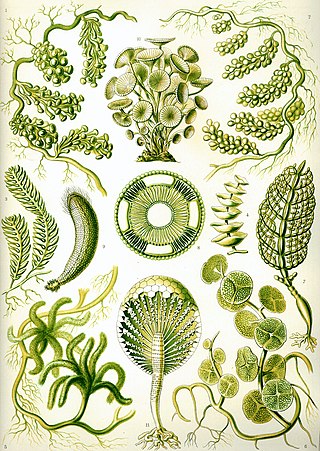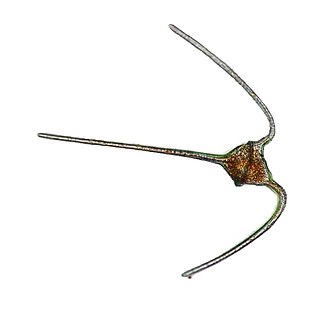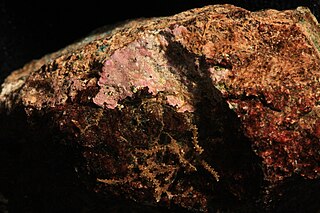
Chlorophyta is a division of green algae informally called chlorophytes.

Microsporidia are a group of spore-forming unicellular parasites. These spores contain an extrusion apparatus that has a coiled polar tube ending in an anchoring disc at the apical part of the spore. They were once considered protozoans or protists, but are now known to be fungi, or a sister group to true fungi. These fungal microbes are obligate eukaryotic parasites that use a unique mechanism to infect host cells. They have recently been discovered in a 2017 Cornell study to infect Coleoptera on a large scale. So far, about 1500 of the probably more than one million species are named. Microsporidia are restricted to animal hosts, and all major groups of animals host microsporidia. Most infect insects, but they are also responsible for common diseases of crustaceans and fish. The named species of microsporidia usually infect one host species or a group of closely related taxa. Approximately 10 percent of the known species are parasites of vertebrates — several species, most of which are opportunistic, can infect humans, in whom they can cause microsporidiosis.

Amanita gemmata, commonly known as the gemmed amanita or the jonquil amanita, is an agaric mushroom of the family Amanitaceae and genus Amanita. The fruit body has a cap that is a dull to golden shade of yellow, and typically 2.5–12 centimetres in diameter. The cap surface is sticky when moist, and characterized by white warts, which are easily detached. It is initially convex, and flattens out when mature. The flesh is white and does not change colour when cut. The gills are white and closely spaced. The stem is pale yellow, and measures 4–12 cm long by 0.5–1.9 cm thick. The partial veil that covers the young fruit body turns into the ring on the stem at maturity. The spore print is white. It resembles numerous other species.

Tetradesmus lagerheimii is a green alga in the family Scenedesmaceae. It is also known by its synonym, Scenedesmus acuminatus.

Botryococcus is a genus of green algae. It is a microscopic or semi-microscopic alga that is found in freshwater habitats worldwide. It consists of colonies of cells in an irregular, gelatinous matrix.

Geminella is a genus of green algae in the phylum Chlorophyta. Once considered part of the order Ulotrichales, molecular phylogenetics have shown that Geminella and related genera form a well-supported clade within the class Trebouxiophyceae.

Gloeotila is a genus of green algae in the class Trebouxiophyceae. It is typically found in freshwater habitats, either attached to surfaces or planktonic, or found in soil.

Microthamnion is a genus of green algae in the family Microthamniaceae. It is found in freshwater habitats around the world, preferably with low levels of pollution; it is typically attached to solid substrates.

Schroederiella is a genus of green algae in the family Scenedesmaceae.

The genus Ceratium is restricted to a small number of freshwater dinoflagellate species. Previously the genus contained also a large number of marine dinoflagellate species. However, these marine species have now been assigned to a new genus called Tripos. Ceratium dinoflagellates are characterized by their armored plates, two flagella, and horns. They are found worldwide and are of concern due to their blooms.
Komma caudata is a cryptomonad, and the only described species in the genus Komma, although four or five more species may exist. Its cells are 4.5–5.5 μm wide by 7–10 μm long and bear two unequal flagella.

Stenacron is a genus of mayfly in the family Heptageniidae, with a distribution across eastern North America.

Hildenbrandia is a genus of thalloid red alga comprising about 26 species. The slow-growing, non-mineralized thalli take a crustose form. Hildenbrandia reproduces by means of conceptacles and produces tetraspores.

Morchella importuna is a species of fungus in the family Morchellaceae described from North America in 2012. It occurs in gardens, woodchip beds, and other urban settings of northern California and the Pacific Northwest region of the United States and Canada. The fungus has also been reported from Turkey, Spain, France, Switzerland, Canada and China, although it is unknown whether this is a result of accidental introductions. It is considered a choice edible mushroom. The fruit bodies develop a distinctive ladder-like pattern of pits and ridges on the surface of their conical caps.

Tetradesmus obliquus is a green algae species of the family Scenedesmaceae. It is commonly known by its synonym, Scenedesmus obliquus. It is a common species found in a variety of freshwater habitats.

Hypericum sechmenii, or Seçmen's St John's wort, is a rare species of flowering plant of the St John's wort family (Hypericaceae) that is found in the Eskişehir Province of central Turkey. It was first described in 2009 by Turkish botanists Atila Ocak and Onur Koyuncu, who named the species in honor of Özcan Seçmen, a fellow botanist. They assigned the species to the genus Hypericum, and Norman Robson later placed H. sechmenii into the section Adenosepalum.

Aphanothece is a polyphyletic genus with 63 accepted species. The name is derived from the Greek words, ‘aphanes’ and ‘theke’ which mean “invisible" and “box or sheath” respectively. This genera is cosmopolitan, found in soils, thermal springs and other benthic, freshwater, marine, hypersaline, and moist terrestrial environments. Morphology can vary, with both microscopic and macroscopic colonies large enough to be collected and preserved in herbarium records.

Apiocystis is a genus of algae belonging to the family Tetrasporaceae. It is found attached to freshwater aquatic algae or plants. The species of this genus are found in Europe and Northern America, and are widespread but generally uncommon.
Chlorolobion, sometimes spelled Chlorolobium, is a genus of algae belonging to the family Selenastraceae. The species of this genus are found in freshwater habitats in Europe and America.

The Pterocladiaceae is a small family of red algae containing 2 genera of agarophytes.















